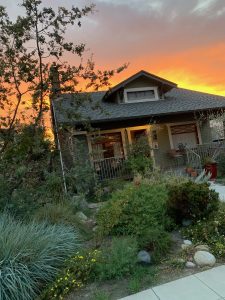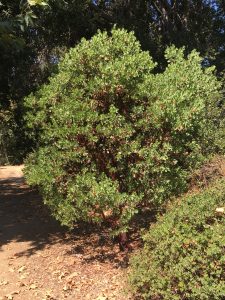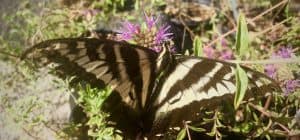
Summer 2019. If you’re located at an inland station, that is any place that gets very little or no nighttime overcast nor early morning cooling moisture from the sea, you know it’s hot. If you are near the coast, it’s hot, but not as hot as it is inland. Just to be sure, both places will be getting hotter this month.
Natives can handle the heat. They do not use or lose much water, as they are adapted to hot dry summers, but all plants, even the most water-efficient natives, use water for cooling, growth, and in some cases just to hold onto life until it gets cooler.
Our 22” rain season or 2018/2019 provided fantastic growth and blooms in California’s gardens, both wild and tamed. The effects are still evident with summer bloomers like the buckwheats and sunflowers taking their turns.
Watering
Don’t water when it’s hot. Avoid applying water during heat waves (if possible) and also during the hot part of the day. How to achieve this? Apply water, deep soak (the equivalent of 1-1.5” rainfall) to all the soil in anticipation of extreme heat. How to do this? Watch the weather forecast. Ideally, you are giving your garden one deep soak every 3-4 weeks. But if you are two weeks into your cycle, and you see the forecast for extreme heat to come in the week your schedule would have you watering, it would be better to water a week early in anticipation of the heatwave. Apply water early in the morning. For most sprinkler systems, the valve has to run for about an hour and a half to apply 1.25” precipitation rate. That’s too long to run one valve! you say, and you’re right.
Deep Soak. Here’s your method. Water your garden starting in the wee hours of the morning. As you cycle through all the valves, times passes, allowing air to follow the water into the root zone. Repeat the cycle later that same day (finishing no later than 10 am) or by running the cycle the very next day. Two irrigations of 40-45 minutes each equals 1.5 hours providing a little over 1 inch of precipitation. That’s a deep soak, two waterings with an intermission in the middle, allowing the soil to “breathe.” You do this once every 3-4 weeks in summer.
Refreshing Sprinkle. This is fun. Now that you know you have applied deep moisture where the roots can find water and oxygen in deep cool soils, you can give your garden a special treat by cooling it off before nightfall. In summer, a couple times a week or so, go out when the sun is low (it might still be hot, but that’s OK) and spray down the entire garden with a nozzle on your hose. Wet the leaves, the soil surface the branches, everything… for about 5-10 minutes… but know this: you are not watering the root zone. At best you are getting the top 1/2” of soil moist, and wetting all the leaves. The plants and the soil surface cool down instantly, some plants will actually absorb a little water through their leaves, they will have an easy night, and be ready for tomorrow’s heat. A hummingbird may even bless you by zipping in for a quick bath.
Related to Watering
All the information above is available here. Just remember that plants make healthy roots in cool soils where there is a healthy combination of moisture and oxygen. Natives do not need to be in soil that is always sopping wet. It harms them in summer. Water deep and wait a spell for the soil to dry out a little before watering again.
Pruning
No major pruning in summer. Only deadheading (removing spent flowers and seed heads), pinching, (removing branch tips to direct new growth) and a little light shaping as necessary.
Weeding
If you have lush weeds in summer you have a) a bog, b) waterlogged soil c) a garden you’re watering too frequently or d) heavy heavy soil that supports weeds even when there is little water being applied or e) a leaky hose. A few weeds are understandable, but many lush weeds would imply too much water on the surface.
Mulching/Topdress
No new mulch. If you have old mulch that was brought in before reading this, and it is the kind of stringy, dusty, flaky junk that has unfortunately made its way into so many landscapes, and it has formed a thick impenetrable mat (like mattress, pillow) on your soil surface, you need to take immediate action. That bad mulch dries out to repel water. It prevents the soil from “breathing,” technically called air exchange, oxygen in, CO2 out (and other gases back and forth). It heats up in the composting process and cooks stems and leaves that are touching it. All in all, that is bad news. Get it out of there and then break up whatever thin layer you have left behind so that water and air can move through it, effectively entering and exiting the soil beneath. Put the mulch in the trash. In the fall we’ll talk about “top dress”, a better title for the high-quality material you might want on the surface of your garden soil.
Feeding
No feeding in summer on most native plants, except containers and heat-loving desert plants.
Troubleshooting – Varmints, Pests, and Diseases
Bunnies – Bad news on grasses. They are nocturnal. Take a hint from Elmer Fudd (all you youngsters can google him) and get rid of bunnies, pray for the owls to have success, or don’t plant grasses.
Insect pests – In summer, you may notice leaves with holes chewed in them. If they are not caused by snails and slugs (who actually rasp the leaves, for they do not chew) then it may be a caterpillar or a grasshopper. Check carefully for slime trails; if present, suspect snails/slugs. If absent and you also find frass (caterpillar poop) then you have insects or insect larvae with chewing mouthparts. They are common this time of year. Caterpillars turn into butterflies or moths, and grasshoppers tend to move on. The holes in the leaves are there to stay, so the basic treatment in the natural garden is to do nothing but be happy that you are providing food in the food chain, and that maybe a phoebe or flycatcher will eat the grasshopper. And when the caterpillar becomes a butterfly (or nondescript moth) the circle of life is complete. And you were part of it!
Disease – With warm soil comes the potential for root rot if all the roots are in the top 4” of soil… which is what happens when water is applied too little, too frequently. Avoid root rot disease by watering properly and encouraging deep roots. Diseases of stems and leaves are usually related to warm humid nights (June into July). As we get into hot dry weather, fungal and bacterial disease on leaves should not be a problem, unless sprinkler water is coming on frequently and hitting the leaves.
Annual Wildflowers
Dream about sowing seed in fall and enjoying flowers in spring.
Adding New Plants
Come on over. We have a large selection of heat-loving plants or shade plants that can be handled now. If you are planning a large area or a complete landscape conversion, call us and we’ll walk you through what to do now so you can plant successfully in October.
 Engage
Engage
Our native flora endures and even thrives in our hot summers, and so do our native gardeners. Try this: Go to one spot in your garden where plants are blooming, visiting early morning, midday, and evening. You will see different beneficial insects, pollinators, and birds, and of course your friend the lizard on the rock. All these wonderful residents are part of your garden’s natural rhythm. They come and go in shifts. If you have night-blooming white flowers, you might even see how the patterns extend into the dark hours.
Even when it seems that your plants are barely holding on for dear life in the heat, they are actually providing dear life for a multitude of species, including us, who get to see it all up close and personal, if we only make the time. Happy heatwave.
From the Garden,
Mike Evans
P.S. For more information about this month, check our website for installments of these monthly newsletters from previous years.
Questions? Help is just one call or one email away. Call (949) 728-0685 or email (with pictures if you like) our special helpline: gardenhelp@californianativeplants.com
To get our monthly updates sign up for our eNewsletter at this link here.